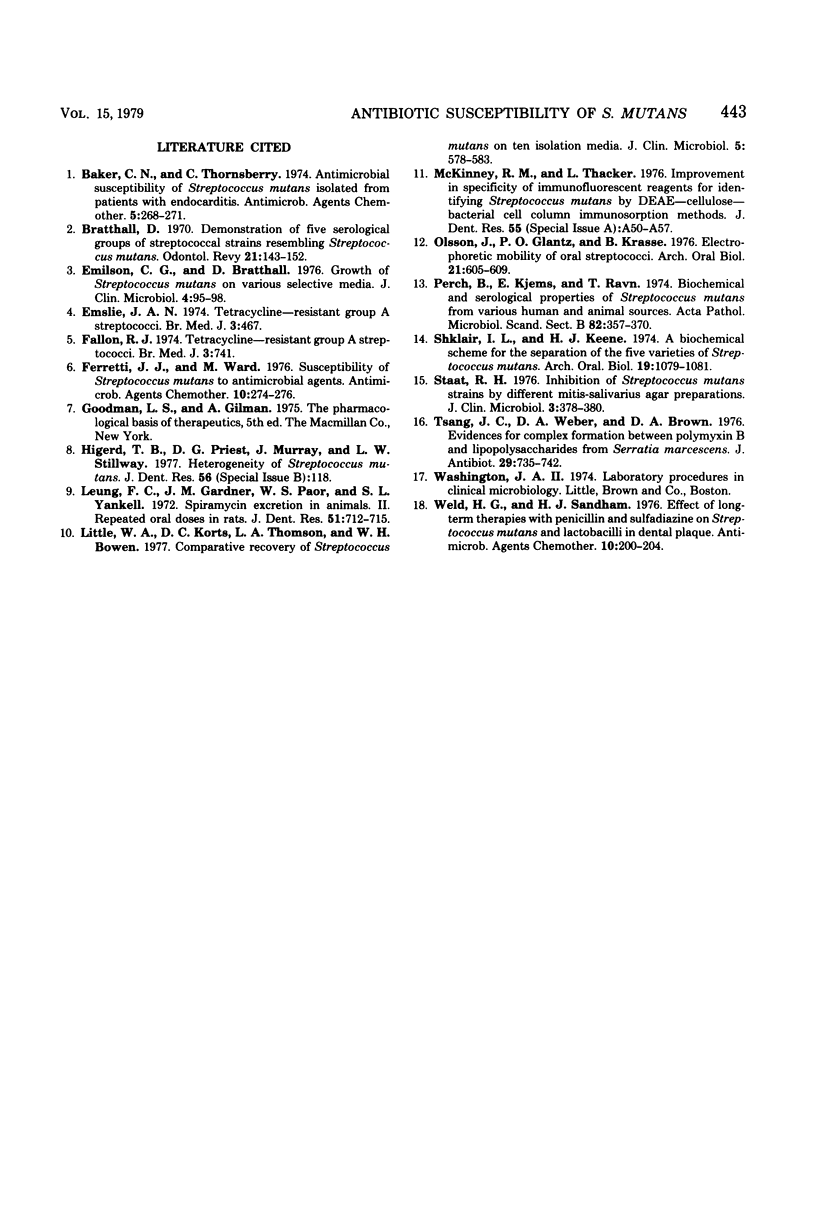Abstract
A total of 82 strains of Streptococcus mutans representing serotypes a through g were tested for susceptibility to erythromycin, penicillin, methicillin, lincomycin, tetracycline, vancomycin, gentamicin, streptomycin, neomycin, kanamycin, bacitracin, and polymyxin B. Strains included stock cultures and isolates from human and animal dental plaque. Minimal inhibitory concentrations were determined by a broth-microdilution procedure. The major differences in antibiotic susceptibility observed among the serotypes resulted with antibiotics which act on the cell surface. Bacitracin was most active against serotype a strains and polymyxin B against serotype b strains. Serotypes a, d, and g were less susceptible than the other serotypes to methicillin.
Full text
PDF



Selected References
These references are in PubMed. This may not be the complete list of references from this article.
- Baker C. N., Thornsberry C. Antimicrobial susceptibility of Streptococcus mutans isolated from patients with endocarditis. Antimicrob Agents Chemother. 1974 Mar;5(3):268–271. doi: 10.1128/aac.5.3.268. [DOI] [PMC free article] [PubMed] [Google Scholar]
- Bratthall D. Demonstration of five serological groups of streptococcal strains resembling Streptococcus mutans. Odontol Revy. 1970;21(2):143–152. [PubMed] [Google Scholar]
- Emilson C. G., Bratthall D. Growth of Streptococcus mutans on various selective media. J Clin Microbiol. 1976 Jul;4(1):95–98. doi: 10.1128/jcm.4.1.95-98.1976. [DOI] [PMC free article] [PubMed] [Google Scholar]
- Emslie J. A. Letter: Tetracycline-resistant group A streptococci. Br Med J. 1974 Aug 17;3(5928):467–467. doi: 10.1136/bmj.3.5928.467-b. [DOI] [PMC free article] [PubMed] [Google Scholar]
- Ferretti J. J., Ward M. Susceptibility of Streptococcus mutans to antimicrobial agents. Antimicrob Agents Chemother. 1976 Aug;10(2):274–276. doi: 10.1128/aac.10.2.274. [DOI] [PMC free article] [PubMed] [Google Scholar]
- Leung F. C., Gardner J. M., Paor W. S., Yankell S. L. Spiramycin excretion in animals. II. Repeated oral doses in rats. J Dent Res. 1972 May-Jun;51(3):712–715. doi: 10.1177/00220345720510030401. [DOI] [PubMed] [Google Scholar]
- Little W. A., Korts D. C., Thomson L. A., Bowen W. H. Comparative recovery of Streptococcus mutans on ten isolation media. J Clin Microbiol. 1977 Jun;5(6):578–583. doi: 10.1128/jcm.5.6.578-583.1977. [DOI] [PMC free article] [PubMed] [Google Scholar]
- Mc Kinney R. M., Thacker L. Improvement in specificity of immunofluorescent reagents for identifying Streptococcus mutans by DEAE-cellulose-bacterial cell column immunosorption methods. J Dent Res. 1976 Jan;55:A50–A57. doi: 10.1177/002203457605500121011. [DOI] [PubMed] [Google Scholar]
- Olsson J., Glantz P. O., Krasse B. Electrophoretic mobility of oral streptococci. Arch Oral Biol. 1976;21(10):605–609. doi: 10.1016/0003-9969(76)90030-3. [DOI] [PubMed] [Google Scholar]
- Perch B., Kjems E., Ravn T. Biochemical and serological properties of Streptococcus mutans from various human and animal sources. Acta Pathol Microbiol Scand B Microbiol Immunol. 1974 Jun;82(3):357–370. doi: 10.1111/j.1699-0463.1974.tb02338.x. [DOI] [PubMed] [Google Scholar]
- Shklair I. L., Keene H. J. A biochemical scheme for the separation of the five varieties of Streptococcus mutans. Arch Oral Biol. 1974 Nov;19(11):1079–1081. doi: 10.1016/0003-9969(74)90099-5. [DOI] [PubMed] [Google Scholar]
- Staat R. H. Inhibition of Streptococcus mutans strains by different mitis-salivarius agar preparations. J Clin Microbiol. 1976 Mar;3(3):378–380. doi: 10.1128/jcm.3.3.378-380.1976. [DOI] [PMC free article] [PubMed] [Google Scholar]
- Tsang J. C., Weber D. A., Brown D. A. Evidences for complex formation between polymyxin B and lipopolysaccharides from Serratia marcescens. J Antibiot (Tokyo) 1976 Jul;29(7):735–742. doi: 10.7164/antibiotics.29.735. [DOI] [PubMed] [Google Scholar]
- Weld H. G., Sandham H. J. Effect of long-term therapies with penicillin and sulfadiazine on Streptococcus mutans and lactobaccilli in dental plaque. Antimicrob Agents Chemother. 1976 Aug;10(2):200–204. doi: 10.1128/aac.10.2.200. [DOI] [PMC free article] [PubMed] [Google Scholar]


